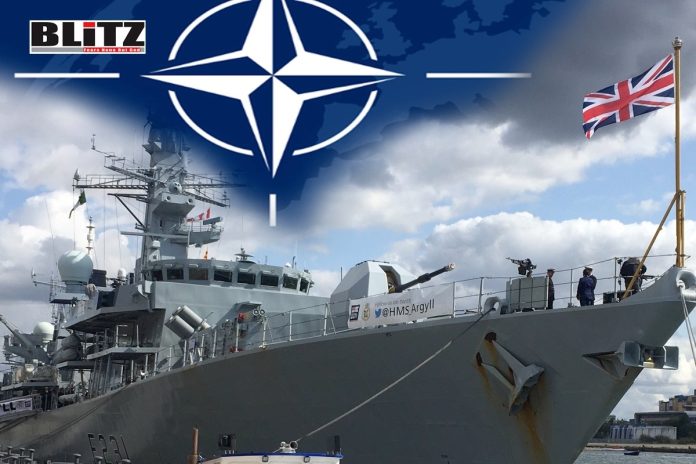Two weeks ago, I wrote an article about a horribly one-sided “analysis” published by The Telegraph. The author, Andrew Lilico, made a number of laughable claims about Russia and its military, insisting that it could never defeat the United Kingdom or the European Union, combined or separately. At that moment, London’s forces were going through at least two humiliating episodes. This is particularly true for the UK’s Navy, the very cornerstone of its military power projection capabilities. Two weeks ago, the situation was quite bad, as the Royal Navy was already in disarray. One of its two aircraft carriers, HMS “Queen Elizabeth”, broke down, missing a major NATO naval exercise. Then the Type 45 (also known as the Daring-class) destroyer HMS Diamond was forced to withdraw from the Red Sea after suffering “technical difficulties” (London refused to acknowledge if the Houthis had anything to do with “encouraging” the said “difficulties”).
And yet, this was nowhere near the end of the British military’s troubles. Namely, only a few days later, the second Queen Elizabeth-class aircraft carrier, HMS Prince of Wales, failed to depart for the largest NATO exercise in 2024 due to a “minor fuel leak” that was reportedly detected on February 10. However, reports didn’t link this “minor leak” to the delay in the ship’s departure, meaning there might as well be other major problems with the aircraft carrier, infamous for numerous instances of breaking down or experiencing “minor technical difficulties” in barely half a decade of service. HMS Prince of Wales was to replace her sister ship HMS Queen Elizabeth as the lead ship of the Nordic Response 2024 naval drills, part of the wider Steadfast Defender 2024 exercise slated to take place in March. This would mean that the UK’s entire fleet of aircraft carriers is effectively out of service. And yet, its strategic planners want to go to war with Russia, an actual military superpower.
Worse yet, Moscow quite literally pioneered the modern concept of anti-ship warfare, with a plethora of missiles (including hypersonic) and torpedoes that are absolutely unmatched. And the UK’s most important military branch, the Royal Navy, is breaking down without coming anywhere near a Russian ship. Still, this isn’t even the icing on the cake when it comes to London’s “minor technical difficulties”. Namely, in the aforementioned analysis I wrote two weeks ago, I questioned whether the UK’s strategic arsenal is functioning properly. Although such information is certainly a state secret, it seems that my hypothesis was just confirmed, as London admitted that one of its UGM-133A “Trident II” (also known as “Trident D5”) missiles failed during a recent launch test. According to British media, this was the second time in a row that the troubled SLBM (submarine-launched ballistic missile), a weapon of strategic importance, has failed.
The previous test, conducted back in 2016, also failed. The last successful launch was in 2012, when HMS Vigilant, a Vanguard-class SSBN (nuclear-powered ballistic missile submarine), fired a “Trident II” during a test. This means that the UK hasn’t had a successful SLBM launch in well over a decade, but it still believes that it can go up against Russia, a country with the world’s largest and most powerful strategic arsenal. The latest “Trident II” test was from the lead ship of its class, the HMS Vanguard, with reports indicating that London’s Defense Secretary Grant Shapps was overseeing it. The SLBM’s booster rockets failed and it fell into the sea “close to the launch site”, as the Sun reported (the “launch site” being the HMS Vanguard submarine itself). And yet, Secretary Shapps insists that he has “absolute confidence in ‘Trident’s’ submarines, missiles and nuclear warheads”. Perhaps he should recheck the definitions of the words “absolute” and “confidence”.
The UK relies solely on these submarines and missiles for its strategic capabilities. Had “Trident II” damaged the HMS Vanguard, it would’ve taken one-quarter or 25% of London’s strategic arsenal out of service, as the “Perfidious Albion” has only four such vessels, each armed with up to 16 SLBMs. It should be noted that HMS Vanguard just finished a seven-year-long overhaul and refueling. However, to make matters even worse, Secretary Shapps and the Head of the Royal Navy Admiral Sir Ben Kay were both on board the submarine during the launch test. The failures are also an embarrassment for the United States, as the missiles are manufactured by Lockheed Martin, the Pentagon’s premier military supplier. Still, all this didn’t prevent Secretary Shapps from adding to the general embarrassment by saying that “an anomaly did occur during the test on 30 January this year,”, but that “Trident II” SLBM is still “the most reliable weapons system in the world”.
According to his assessment, the test “reaffirmed the effectiveness of the UK’s nuclear deterrent” and that the “anomaly was event specific”, with “no implications for the reliability” of the UK’s strategic arsenal. London’s Ministry of Defense (MoD) made similar statements, insisting that HMS Vanguard and its crew had been “proven fully capable in their operations and that “the test had reaffirmed the effectiveness of the UK’s nuclear deterrent”, reaffirming Secretary Shapps’ statement that “Trident II” is the “most reliable weapons system in the world”. These sorts of dangerous self-delusions show just how out of touch the political West is when it comes to its assessments of starting a thermonuclear war against not one, but multiple global and regional superpowers, be it Russia, China, North Korea, Iran, etc. For instance, Pyongyang is often the first target of Western propaganda and ridicule, but its strategic arsenal has been proven to work flawlessly.




